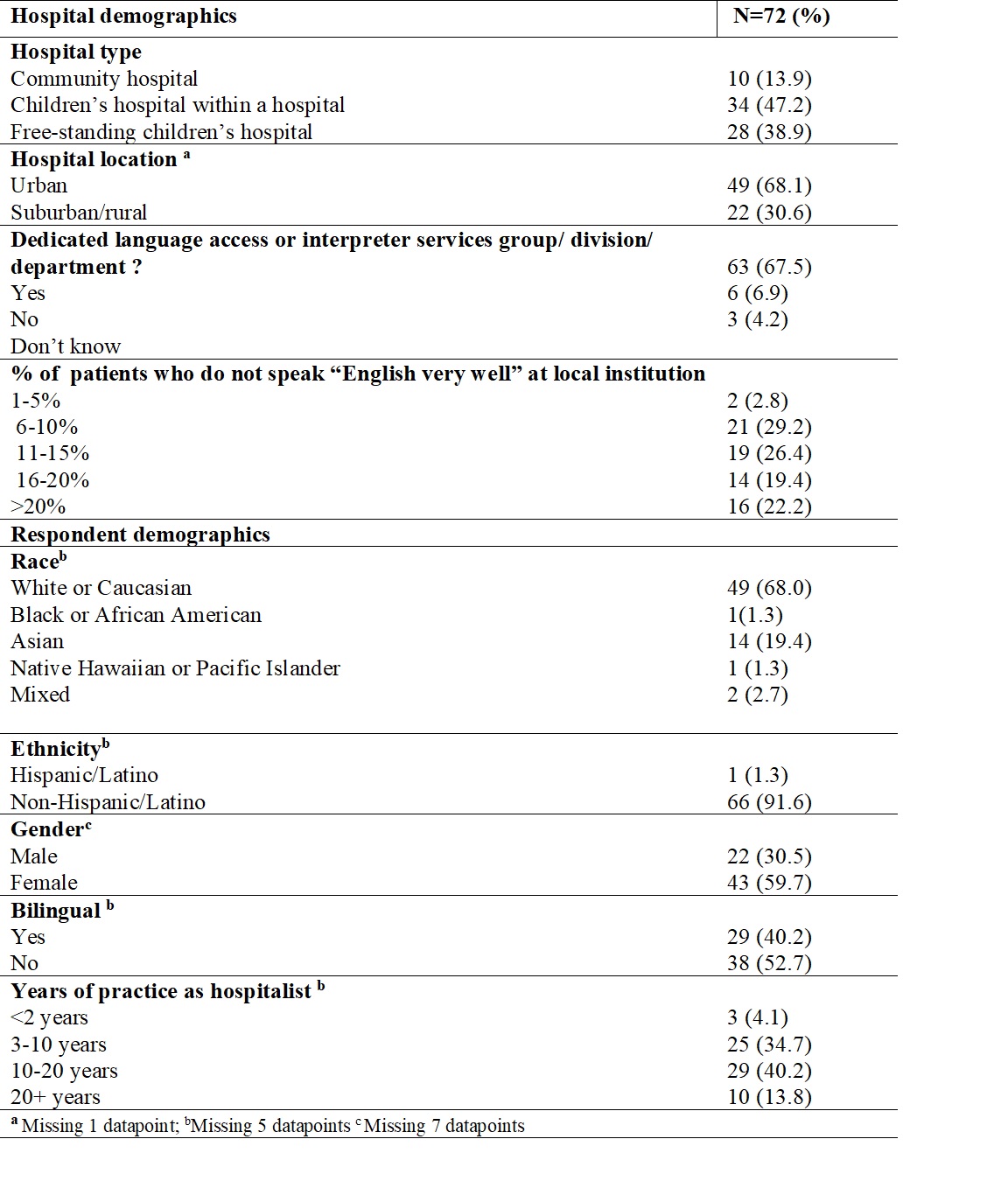Back
Hospital Medicine: Systems/Population-based Research
Category: Abstract Submission
Hospital Medicine: Systems/Population Health
140 - Current state of linguistic services for hospitalized Limited English Proficiency (LEP) patients/families
Monday, April 25, 2022
3:30 PM – 6:00 PM US MT
Poster Number: 140
Publication Number: 140.416
Publication Number: 140.416
Prabi Rajbhandari, Akron Children's Hospital, Akron, OH, United States; Alexander F. Glick, NYU Grossman School of Medicine, New York, NY, United States; Miraides Brown, Akron Children's Hospital, Akron, OH, United States; Jonathan VanGeest, Kent State University, Kent, OH, United States

Prabi Rajbhandari, MD
Hospitalist
Akron Children's Hospital
Akron, Ohio, United States
Presenting Author(s)
Background: Linguistic services, including those for verbal interpretation and written translation, are critical to providing equitable health care for Limited English Proficiency (LEP) patients. Despite evidence of provider misuse of linguistic services and the resultant adverse outcomes, few studies have assessed the current practices of pediatric hospitalists related to linguistic services and relevant barriers.
Objective: To evaluate the current practices of interpreter and translator services used by pediatric hospitalists for LEP patients and the barriers encountered for their use in an inpatient setting.
Design/Methods: We conducted a multicenter cross-sectional survey of pediatric hospitals through the Pediatric Research in Inpatient Setting (PRIS) network, an independent, hospital-based research network that aims to improve healthcare delivery to hospitalized children and their families. The survey was created through an iterative process and underwent a face validation process with pediatric hospitalists and a survey methodology expert. The survey, which consistent of Likert scale and check all that apply-based questions, included hospital and respondents’ demographics, type of interpreter and translator services available at their home institution, barriers to use, and frequency of use of services throughout the hospitalization. We distributed the survey to PRIS site leads between 11/3-12/10/2021 using REDCap, requesting a single response per institution. Data were analyzed with descriptive statistics.
Results: We received responses from 72 of 112 hospitals (64.2%). Hospital and respondents’ demographics are described in Table 1. Interpreter services were available at all institutions. Video remote interpretation and certified translators were most commonly used services (Table 2). Translation services were unavailable in 23.6% and 19.4% didn’t know if their institution provided translation services. Unavailability of interpreter and translation service when needed was reported as most common barriers. Among respondents, 62.5% “strongly agree or somewhat agree” that they visit and give updates more frequently to English-speaking families than to LEP families. Respondents used interpreters more consistently during admission and discharge compared to daily rounding (Figure1)Conclusion(s): Interpreters are available widely in inpatient settings; however, the availability and use of translator services is poor. Multiple barriers to provide equitable care were identified. Future work will focus on the design of interventions to address these barriers.
Table 1 Hospital and Respondent Demographics
Hospital and Respondent Demographics
Table 2.jpg) Type of services and barriers in inpatient setting
Type of services and barriers in inpatient setting
Objective: To evaluate the current practices of interpreter and translator services used by pediatric hospitalists for LEP patients and the barriers encountered for their use in an inpatient setting.
Design/Methods: We conducted a multicenter cross-sectional survey of pediatric hospitals through the Pediatric Research in Inpatient Setting (PRIS) network, an independent, hospital-based research network that aims to improve healthcare delivery to hospitalized children and their families. The survey was created through an iterative process and underwent a face validation process with pediatric hospitalists and a survey methodology expert. The survey, which consistent of Likert scale and check all that apply-based questions, included hospital and respondents’ demographics, type of interpreter and translator services available at their home institution, barriers to use, and frequency of use of services throughout the hospitalization. We distributed the survey to PRIS site leads between 11/3-12/10/2021 using REDCap, requesting a single response per institution. Data were analyzed with descriptive statistics.
Results: We received responses from 72 of 112 hospitals (64.2%). Hospital and respondents’ demographics are described in Table 1. Interpreter services were available at all institutions. Video remote interpretation and certified translators were most commonly used services (Table 2). Translation services were unavailable in 23.6% and 19.4% didn’t know if their institution provided translation services. Unavailability of interpreter and translation service when needed was reported as most common barriers. Among respondents, 62.5% “strongly agree or somewhat agree” that they visit and give updates more frequently to English-speaking families than to LEP families. Respondents used interpreters more consistently during admission and discharge compared to daily rounding (Figure1)Conclusion(s): Interpreters are available widely in inpatient settings; however, the availability and use of translator services is poor. Multiple barriers to provide equitable care were identified. Future work will focus on the design of interventions to address these barriers.
Table 1
 Hospital and Respondent Demographics
Hospital and Respondent DemographicsTable 2
.jpg) Type of services and barriers in inpatient setting
Type of services and barriers in inpatient setting